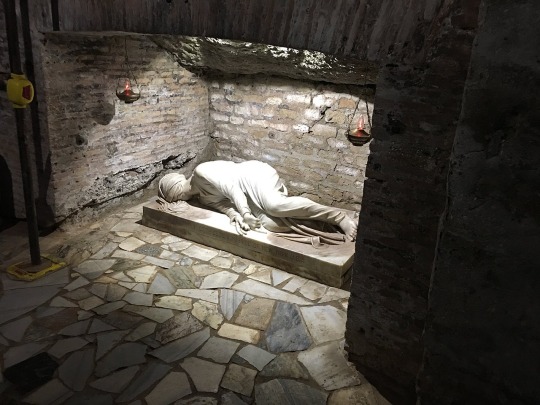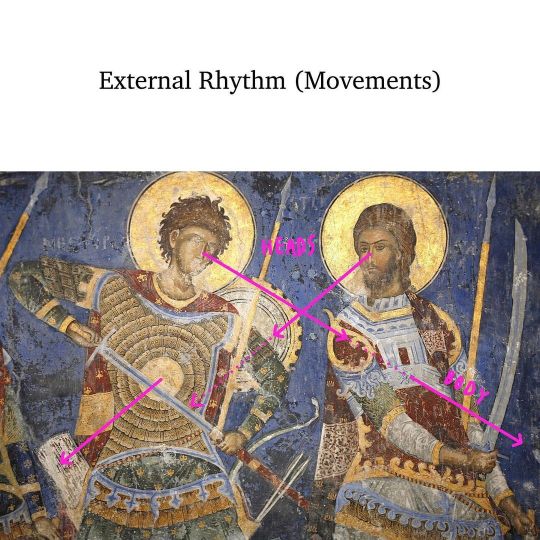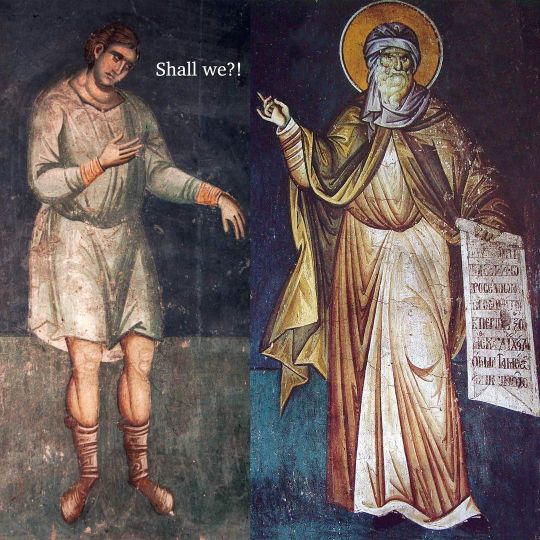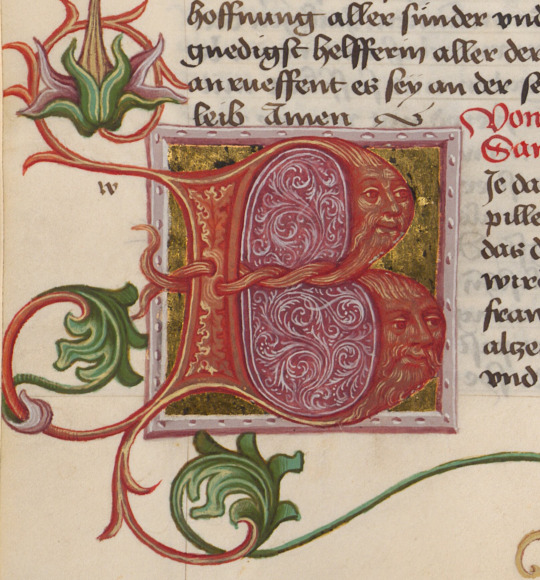#hagiographie
Text
Mönch und Ikonenmaler

Mönch und Ikonenmaler ⋆ Maghreb Sage ⋆ Hagiographie
In Maghrebinien gab es vor Zeiten einen Ikonen-Maler, der noch die hohe Kunst beherrschte, die Heiligen so darzustellen, wie es Vorschrift war von altersher.
Zu ihm kam einst der Mönch Simeon, und überbrachte ihm den Auftrag, eine Ikone zu malen, kostbar in Gold, Purpur und Karmesin.
Der Ikonen-Maler nahm den Auftrag an, forderte auch eine ungeheure Summe im voraus, erhielt sie und ließ nichts mehr von sich hören.
Nach zwanzig Wochen machte sich der Mönch Simeon wieder auf zu ihm, um zu erfahren, ob das Weihe-Bild denn fertig wäre.
Er fand aber den Ikonen-Maler inmitten der wilden Schar seiner Freunde besinnungslos betrunken vor und einige der Gäste begannen bereits aufzubrechen, denn der letzte Para (Münze) war offensichtlich schon versoffen.
Simeon wartete bis alle sich entfernt hatten und der Ikonen-Maler wieder zu sich gekommen war. Dann stellte er ihn zur Rede.
»Weiß du«, sagte der Ikonen-Maler, aus der Tiefe seines Rausches langsam zum Bewusstsein aufsteigend wie der Schwammtaucher zum Meerespiegel, »weiß du denn, Mönch, was es heißt, ein Bild zu malen?«
»Zwanzig Wochen lang habe ich von dem Geld, das du mir gegeben hast, gesoffen und im Höllenpfuhl des Lasters und der Völlerei gelegen. Nun werde ich zwanzig Wochen lang fasten und mich läutern. Und wenn Gott mir gnädig war und ich mich geläutert habe, dann werde ich in den Wald gehen und so lange und so tief werde ich gehen, bis unter den Bäumen des Waldes einer mich ruft. Und diesen Baum werde ich dann fällen und mir aus seinem Holz ein Brettchen schneiden.«
»Dann erst«, so sagte der Ikonen-Maler zum Mönch Simeon, »werde ich ein Brettchen haben, auf dem ich – wenn mir Gott weiter gnädig ist – versuchen werde, das Bild zu beginnen.«
Lehre: Gut Ding will Weile haben!
Mönch und Ikonenmaler ⋆ Maghreb Sage ⋆ Hagiographie
Read the full article
0 notes
Text

st. magnus catching birds
illustration for a vita of st. magnus of füssen, st. gallen, c. 1451-60
source: St. Gallen, Stiftsbibl., Cod. Sang. 602, p. 161
288 notes
·
View notes
Text

I'll Walk It Off
apparently when they sentenced Saint Sebastian to death, the arrows didn't even kill him and he was nursed back to health when someone found him. that's what they don't tell you in sunday school
327 notes
·
View notes
Text
Trans and Genderqueer Subjects in Medieval Hagiography (ed. Blake Gutt and Alicia Spencer-Hall) is now available open access! This is great news because this book was super expensive, but it's such an important piece of work for premodern queer and gender studies.
#gender theory#queer theory#medieval#trans and genderqueer subjects in medieval hagiography#the introduction to this is very useful for justifying why these topics exist too
536 notes
·
View notes
Text

the cover of the gigantic notebook I have dedicated to my dissertation notes and research is, dare I say, absolutely slaying
#really gets the queer trans medievalist vibe established#also the medieval ones are a sticker set that is also the cover of one of my FAVORITE academic books#(trans and genderqueer subjects in medieval hagiography eds. blake gutt and alicia spencer hall) (wonderful people!)#also filled the space in the top with a sticker that came with a ring I ordered from nominal. it matched the vibe
77 notes
·
View notes
Text
St Cecilia by Stefano Maderno (1599)
In Saint Cecilia in Trastevere, where her relics are kept (supposedly built on the site of her 3rd century house)-

And the same sculpture in the location of her original tomb, in the Catacomb of Callixtus on the Appian Way-

124 notes
·
View notes
Text
The study of history cannot and MUST NOT be reduced to a self-congratulatory collection of revisionists, liars, despots and other corrupt, wealthy old men furiously yanking eachother off in a boardroom over the achievements of their antecedents or wherever.
…
Okay that sounds more like the prelude to a porno.
But still.
My point stands!
I’m condemning self-congratulatory crap like revisionism and the Great Man Theory (which I refuted as part of a thesis I did for my masters degree). And other such stupid shit like that.
#dougie rambles#personal stuff#vent post#political crap#rants#academics#history#anti revisionism#great man theory#bullshit#lies#myths#distortion#fawning idolatry#hagiography
33 notes
·
View notes
Text







A slight alteration of the post from the account byzantinepainting on instagram, "Dancing with the Saints"
300 notes
·
View notes
Text
everybody says fire emblem three houses is a good game but they do NOT talk about how after you play there becomes a real danger of a medieval art history phd. we should be talking about how fe3h aims to convince the youth of today to get a medieval art history phd.
#caught myself looking at medieval art history requirements @ [redacted university] again.#thru tears: reliquaries.............ivories.............hagiography........MANUSCRIPTS#rambles#fe3h#in fe3h's defense i already liked medieval art history i just have spent more time w it recently . :|
10 notes
·
View notes
Text
all i can say is
let the games begin
on april 19th

#me and the girls going hard for the shallow lyrics#unnuanced mental illness references#self serving martyrdom#purple prose and strained metaphors#girl gonna craft her own hagiography#i predict backlash!#anti taylor swift
16 notes
·
View notes
Text
Previously, on Apocrypals part 5: The Fifth One
As we begin our sixth (!) calendar year of Apocrypals, here is a list of the texts we have covered so far on the show in case you want to read along or catch up. They’re arranged in a way that appeases my systematic nature.
Tanakh/Old Testament:
Genesis (episodes 16-20)
Exodus (episodes 33 and 35)
Leviticus (episode 59)
Numbers (episode 62)
Deuteronomy (episode 65)
Joshua (episode 73)
Judges (episode 80)
Ruth (episode 45)
1 Samuel (episode 89)
2 Samuel (episode 90-91)
1 Kings (episode 99)
2 Kings (episode 106)
Esther (episode 37)
Job (episode 101)
Ecclesiastes (episode 52)
Song of Songs (episode 34)
Isaiah (episode 4)
Jeremiah (episode 43-44)
Lamentations (episode 48)
Ezekiel (episode 55-56)
Daniel (episode 2)
Hosea (episode 108)
Jonah (episode 31)
Micah (episode 74)
Nahum (episode 74)
Deuterocanon/capital-A Apocrypha:
Tobit (episode 13)
Judith (episode 22)
Greek Additions to Esther (episode 37)
1 Maccabees (episode 27)
2 Maccabees (episode 28)
3 Maccabees (episode 53)
4 Maccabees (episode 78)
The Prayer of Azariah aka the Song of the Three Holy Children (episode 2)
Susanna (episode 2)
Bel and the Dragon (episode 2)
The Prayer of Manasseh (episode 6)
New Testament:
Matthew (episodes 8-9)
Mark (episode 7)
Luke (episode 10)
John (episode 11-12)
Acts of the Apostles (episode 1)
Romans (episode 5)
1 Corinthians (episode 25)
2 Corinthians (episode 42)
Galatians (episode 72)
Ephesians (episode 81)
Hebrews (episode 104)
1 John (episode 49)
2 John (episode 49)
3 John (episode 49)
Revelation (episode 50)
Pseudepigrapha (Jewish apocrypha):
The Testament of Solomon (episode 24)
The Story of Ahikar (episode 14)
The Ascension of Isaiah (episode 6)
1 Enoch (episode 39-40)
2 Enoch (episode 61)
3 Enoch (episode 86-87)
Jubilees (episodes 82 and 83)
The Letter of Aristeas (episode 70)
The War of the Sons of Light Against the Sons of Darkness (episode 71)
Joseph and Aseneth (episode 93)
New Testament apocrypha:
The Protevangelium aka Infancy Gospel of James (episode 29)
The Acts of Pilate/Gospel of Nicodemus (episode 23)
Mors Pilati/Death of Pilate (episode 23)
The Acts of Paul and Thecla (episode 22)
The Acts of Peter (episode 3)
The Acts of Peter and Paul (episode 3)
The Acts of Andrew and Matthias (episode 60)
The Acts of Thomas and His Wonderworking Skin (episode 66)
The Life of Xanthippe, Polyxena, and Rebecca (episode 57)
Questions of Bartholomew (episode 41)
Resurrection of Jesus Christ by Bartholomew (episode 41)
The Book of Bartholomew (episode 67)
Acts of John (episode 46)
The Acts of Andrew (episode 97)
Syriac Infancy Gospel (episode 47)
Infancy Gospel of Thomas (episode 54)
Infancy Gospel of Pseudo-Matthew (episode 79)
The Adoration of the Magi (2020 Christmas bonus episode)
The History of Joseph the Carpenter (episode 103)
The First Apocryphal Apocalypse of John (episode 68)
The Second Apocryphal Apocalypse of John (episode 68)
The Third Apocryphal Apocalypse of John (episode 68)
The Apocalypse of Peter (episode 75)
The Apocalypse of Paul (episode 95)
The Gospel of Philip (episode 92)
The Gospel of Mary (episode 92)
The Gospel of Jesus’s Wife (episode 92)
The Gospel of Judas (episode 100)
The Greater Questions of Mary (episode Secret 69)
The Golden Legend of Jacobus de Voragine:
The Life of Saint Nicholas (episode 26)
The Life of Saint Lucy (episode 26)
The Life of Saint Christopher (episode 15)
The Life of Saint Benedict (episode 15)
excerpts from The Passion of the Lord (episode 23)
The Life of Saint Sebastian (episode 58)
The Life of Saint Blaise (episode 58)
The Life of Saint Agatha (episode 58)
The Life of Saint Roch (episode 63)
The Life of Saint Catherine of Alexandria (episode 77)
The Life of Saint Barbara (episode 77)
The Life of Saint Dunstan (episode 85)
The Life of Mary Magdalene (episode 94)
The Life of Saint Martha of Bethany (episode 102)
The Life of Saint Margaret of Antioch (episode 102)
Other:
Historia Trium Regum/The Legend of the Three Kings by John of Hildesheim (episode 30)
Muirchu’s Life of Saint Patrick (episode 36)
The Life of Saint Guinefort (episode 63)
The Life of Saint Mary of Egypt (episode 69)
The Life of Saint Pelagia (episode 69)
The Life of Saint Martin by Sulpicius Severus (episode 76)
The Life of Saint Columba (episode 84)
The Life of Saint Wilgefortis (episode 94)
Lives of cephalophoric saints (bonus episode cephalo4)
Stories of the Baal Shem Tov from The Golden Mountain (episode 96)
More stories of the Baal Shem Tov from The Golden Mountain (episode 107)
Solomon and Ashmedai (bonus episode double chai)
Listener questions (episode 32)
Bible trivia questions (episode 38)
Halloween-themed Chick tracts (episode 51)
Christmas-themed Chick tracts (episode 98)
Bible Adventures and the Wisdom Tree catalogue of video games (episode 64)
The Da Vinci Code, the movie (episode 88)
Guess the Bible character from Persona 5 (bonus episode Persona 5)
El Shaddai: Ascension of the Metatron (episode 105)
You can find links to all these episodes with show notes and more on the Apocrypals wiki
#apocrypals#podcast#podcasts#religion#bible#christianity#judaism#apocrypha#old testament#new testament#hagiography
88 notes
·
View notes
Text

decorated initial B
in a hagiographical manuscript, bavaria, 15th c.
source: Munich, BSB, Cgm 6834(1, fol. 23v
196 notes
·
View notes
Text
Ms. Codex 1577 contains stories and legends about Saint Francis and his disciples and followers, plus several other hagiographies and legends, in Italian. Written in northern Italy, possibly Venice or Ferrara, between 1460 and 1480.
Online:
#medieval#renaissance#manuscript#italy#italian#saint francis#hagiography#legend#rare books#book history#illumination#illuminated manuscript#illuminated initial
70 notes
·
View notes



